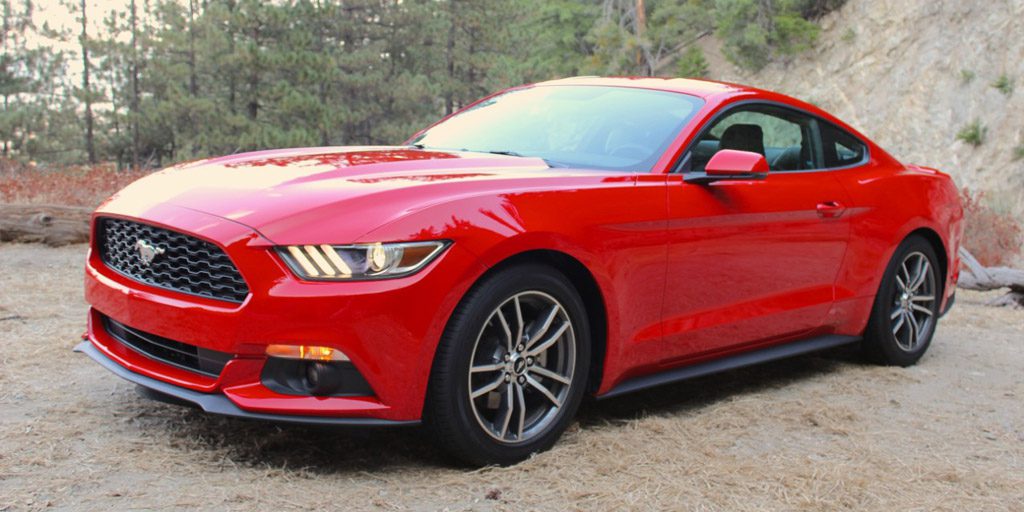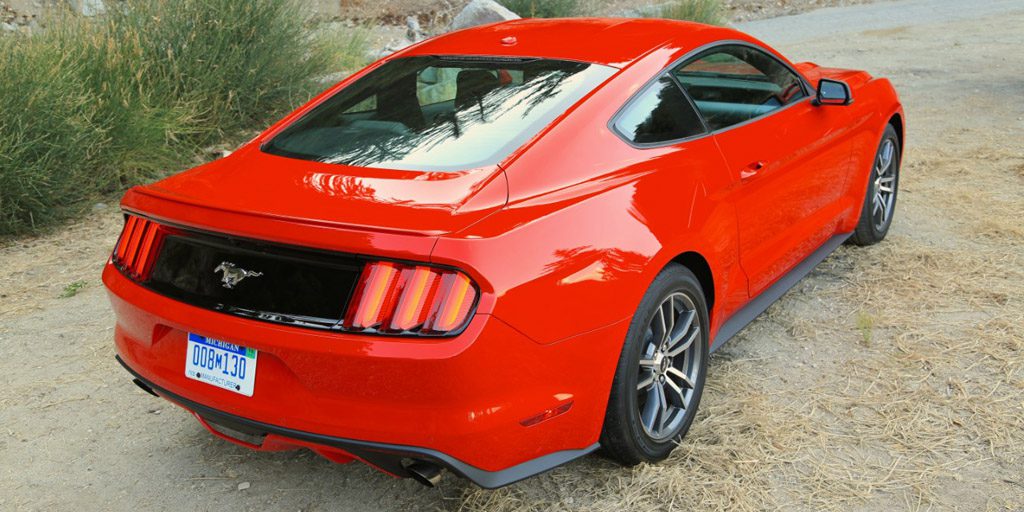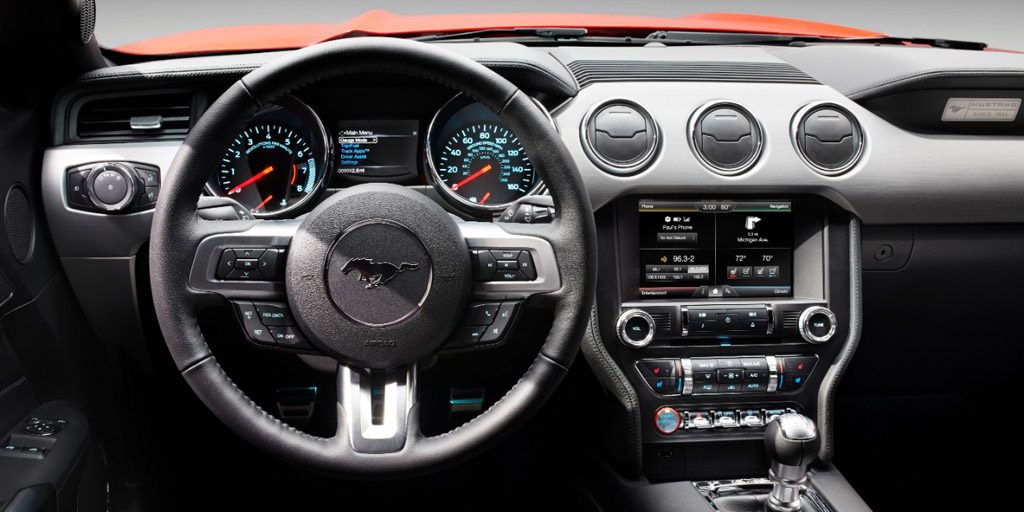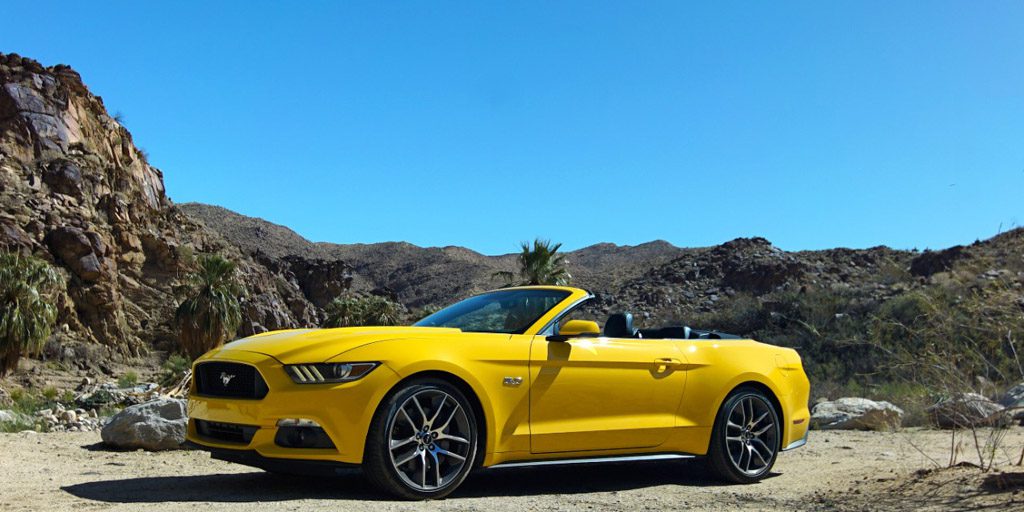For Mustang’s interior, tradition plays an important role. Two round gauges still dominate the instrument panel, and they can again be optionally lit with a selection of different colors. But now the black dashboard is graced with real aluminum trim in a choice of three finishes – including a neat retro “engine turned” look – along with polished and chrome accents. Furthermore, the dashboard top and face are padded – as are the armrests and sides of the center stack – and an optional trim package brings padded door tops. Seats come with a choice of cloth or leather upholstery, the latter offered in black, red, and saddle brown.
Although the hardtop version has a decidedly fastback profile, it’s not a hatchback; rather it has a traditional trunk, as does the convertible. Ford says both trunks can hold two golf bags, even when the car is fitted with the optional trunk-mounted sub-woofers – which didn’t used to be the case. In the fastback, the rear seat backs fold to lengthen the cargo area, but they rest about 3 inches above the level of the trunk floor, making it difficult to slide long items all the way forward.
Although Ford feels that the Mustang’s rear seat gives it an advantage over some two-seat competitors, don’t expect to put full-size adults back there – at least, not for long. Headroom isn’t friendly to those over about 5’6 (and is less than it was in the previous Mustang), and legroom disappears if the seat ahead is more than halfway back. However, Ford feels that area is typically used more for cargo and pets anyway, and regardless of use, the company says the front seat backs now return to their pre-set positions after being moved forward for access. Conversely, there’s plenty of room up front, even for taller occupants.
Visibility has long been a Mustang strong suit – particularly in its class – and the new one carries on that tradition. Front pillars are thin, as are the center pillars (which are positioned far back for a great over-the-shoulder view). Rear pillars are also fairly easy to see around, something that’s too often exactly the opposite.
Although we didn’t get to test a base model (none were made available at the preview), both the EcoBoost and GT versions driven had unusually comfortable front seats, though only the driver’s had adjustable lumbar support.
In the otherwise retro-styled dashboard, the modern, high-tech audio and climate controls look a bit out of place. Also out of place are many of the controls themselves; the standard touchscreen is quite a reach, as are a number of the knobs and buttons. Volume and tuning have their own knobs (the latter being a stretch), with source and station selection being done through the touchscreen. Temperature is adjusted with a vertical rotary knob, but fan speed is by repetitive-step pushbutton, and mode is on the touchscreen. For elements incorporated into the touchscreen, it often takes multiple steps through hard-to-access virtual buttons to get where you used to go in one press of a physical one.
Interior storage is adequate, but no more. The glovebox is arranged so that the owner’s manual is out of the way, leaving a fair amount of space for stuff. Handier to the driver are a small forward console bin with USB and 12-volt plugs, two cupholders, a small console box with USB/Aux/SD card/12-volt plugs, a neat left-side dash bin for sunglasses, and tiny map pockets in the doors.
Whatever minor failings the Mustang has, none are where the rubber meets the road. Here the car impresses with a surprisingly compliant ride, grippy cornering, and serious power, particularly in GT guise. As is characteristic of such engines, the V8 pulls strongly throughout its rev range. Equally characteristic of small turbocharged engines is a moment of lag time from a full-throttle start before power comes on strongly, but the new EcoBoost suffers less of this than most; in fact, stabbing the throttle while turning left from a stop broke the rear tires loose and sent the tail flying about halfway through the intersection. (This would have been more fun had it not been so surprising.) The revised 6-speed manual is a joy to shift, with – at least when coupled to the GT’s V8 – very easy clutch action. The EcoBoost model driven carried the 6-speed automatic, which downshifted fairly quickly for more passing power.
In both models tested (GT and EcoBoost), the suspensions did a great job of soaking up bumps while still providing flat cornering and fine steering response. Credit the new independent rear suspension for some of that, and particularly for reducing the amount of “side stepping” in bumpy corners. All told, this is one impressive road car.
Along with the redesign comes a host of new features. On the safety front, curtain airbags are added for the first time (convertibles will get head-protecting side airbags), as are front knee airbags and a rearview camera, along with available blind-spot alert, cross-traffic alert, and adaptive cruise control. There’s also keyless access and starting, Ford’s SYNC infotainment system, and MyKey, which allows parents to set limits on such things as speed and radio volume. Performance enthusiast might like Ford’s Track Apps, which allows for timing events, and every GT comes with launch control, which can make some of those times a little quicker.




